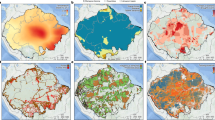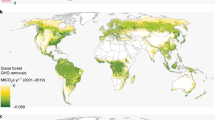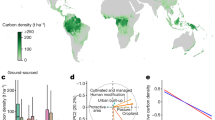Abstract
Currently, the main tools for assessing and managing ecosystem services at large scales are maps providing snapshots of their potential supply. However, many ecosystems change over short timescales; thus, such maps soon become inaccurate. Here we show high rates of short-term dynamics of three key forest ecosystem services: wood production, bilberry production and topsoil carbon storage. Almost 85% of the coldspots and 65% of the hotspots for these services had changed into a different state over a ten-year period. Wood production showed higher rates of short-term dynamics than bilberry production and carbon storage. The high rates of dynamics mean that static snapshot ecosystem service maps provide limited information for assessing and managing multifunctional, dynamic landscapes, such as forests. We advocate that dynamic, spatially explicit tools to assess and manage ecosystem service dynamics be further developed and applied in post-2020 biodiversity and ecosystem service policy supporting frameworks.
This is a preview of subscription content, access via your institution
Access options
Access Nature and 54 other Nature Portfolio journals
Get Nature+, our best-value online-access subscription
$29.99 / 30 days
cancel any time
Subscribe to this journal
Receive 12 digital issues and online access to articles
$119.00 per year
only $9.92 per issue
Buy this article
- Purchase on Springer Link
- Instant access to full article PDF
Prices may be subject to local taxes which are calculated during checkout




Similar content being viewed by others
Data availability
The data used for this study are archived and openly available from the University of Jyväskylä Dataverse Network (http://dvn.jyu.fi/dvn/dv/Boreal_forest).
Code availability
The code used to analyse the data and produce the figures is available from the corresponding author upon request.
References
Foley, J. A. et al. Global consequences of land use. Science 309, 570–574 (2005).
Carpenter, S. R. et al. Science for managing ecosystem services: beyond the Millennium Ecosystem Assessment. Proc. Natl Acad. Sci. USA 106, 1305–1312 (2009).
Nelson, E. et al. Modeling multiple ecosystem services, biodiversity conservation, commodity production, and tradeoffs at landscape scales. Front. Ecol. Environ. 7, 4–11 (2009).
Maes, J. et al. An indicator framework for assessing ecosystem services in support of the EU Biodiversity Strategy to 2020. Ecosyst. Serv. 17, 14–23 (2016).
Maes, J. et al. Mapping ecosystem services for policy support and decision making in the European Union. Ecosyst. Serv. 1, 31–39 (2012).
Millennium Ecosystem Assessment. Ecosystems and Human Well-Being: Synthesis (Island Press, 2005).
Summary for Policymakers. In Global Assessment Report on Biodiversity and Ecosystem Services (IPBES, 2019).
Martínez-Harms, M. J. & Balvanera, P. Methods for mapping ecosystem service supply: a review. Int. J. Biodivers. Sci. Ecosyst. Serv. Manage. 8, 17–25 (2012).
Hauck, J. et al. ‘Maps have an air of authority’: potential benefits and challenges of ecosystem service maps at different levels of decision making. Ecosyst. Serv. 4, 25–32 (2013).
Balvanera, P. et al. Conserving biodiversity and ecosystem services. Science 291, 2047 (2001).
Dick, J., Maes, J., Smith, R. I., Paracchini, M. L. & Zulian, G. Cross-scale analysis of ecosystem services identified and assessed at local and European level. Ecol. Indic. 38, 20–30 (2014).
UK National Ecosystem Assessment. The UK National Ecosystem Assessment Technical Report. (UNEP-WCMC, 2011); http://uknea.unep-wcmc.org/
Orsi, F., Ciolli, M., Primmer, E., Varumo, L. & Geneletti, D. Mapping hotspots and bundles of forest ecosystem services across the European Union. Land Use Policy 99, 104840 (2020).
Holland, R. A. et al. The influence of temporal variation on relationships between ecosystem services. Biodivers. Conserv. 20, 3285–3294 (2011).
Renard, D., Rhemtull, J. M. & Bennett, E. M. Historical dynamics in ecosystem service bundles. Proc. Natl Acad. Sci. USA 112, 13411–13416 (2015).
Rukundo, E. et al. Spatio-temporal dynamics of critical ecosystem services in response to agricultural expansion in Rwanda, East Africa. Ecol. Indic. 89, 696–705 (2018).
Stürck, J., Schulp, C. J. E. & Verburg, P. H. Spatio-temporal dynamics of regulating ecosystem services in Europe—the role of past and future land use change. Appl. Geogr. 63, 121–135 (2015).
Rau, A. L. et al. Temporal patterns in ecosystem services research: a review and three recommendations. Ambio 49, 1377–1393 (2020).
Sutherland, I. J., Bennett, E. M. & Gergel, S. E. Recovery trends for multiple ecosystem services reveal non-linear responses and long-term tradeoffs from temperate forest harvesting. For. Ecol. Manage. 374, 61–70 (2016).
Hansen, M. C., Stehman, S. V. & Potapov, P. V. Quantification of global gross forest cover loss. Proc. Natl Acad. Sci. USA 107, 8650–8655 (2010).
Vanhanen, H. et al. Making Boreal Forests Work for People and Nature (IUFRO, 2012).
Pan, Y. et al. A large and persistent carbon sink in the world’s forests. Science 333, 988–993 (2011).
Moen, J. et al. Eye on the Taiga: removing global policy impediments to safeguard the boreal forest. Conserv. Lett. 7, 408–418 (2014).
Global Forest Industry (Swedish Forest Industries, 2019); https://www.forestindustries.se/forest-industry/statistics/global-forest-industry/
Saastamoinen, O., Kangas, K. & Aho, H. The picking of wild berries in Finland in 1997 and 1998. Scand. J. For. Res. 15, 645–650 (2000).
Gamfeldt, L. et al. Higher levels of multiple ecosystem services are found in forests with more tree species. Nat. Commun. 4, 1340 (2013).
Hou, Y., Li, B., Müller, F., Fu, Q. & Chen, W. A conservation decision-making framework based on ecosystem service hotspot and interaction analyses on multiple scales. Sci. Total Environ. 643, 277–291 (2018).
Blumstein, M. & Thompson, J. R. Land-use impacts on the quantity and configuration of ecosystem service provisioning in Massachusetts, USA. J. Appl. Ecol. 52, 1009–1019 (2015).
Fernandez-Campo, M., Rodríguez-Morales, B., Dramstad, W. E., Fjellstad, W. & Diaz-Varela, E. R. Ecosystem services mapping for detection of bundles, synergies and trade-offs: examples from two Norwegian municipalities. Ecosyst. Serv. 28, 283–297 (2017).
Gissi, E., Fraschetti, S. & Micheli, F. Incorporating change in marine spatial planning: a review. Environ. Sci. Policy 92, 191–200 (2019).
Maxwell, S. M., Gjerde, K. M., Conners, M. G. & Crowder, L. B. Mobile protected areas for biodiversity on the high seas. Science 367, 252–254 (2020).
Willcock, S. et al. Do ecosystem service maps and models meet stakeholders’ needs? A preliminary survey across sub-Saharan Africa. Ecosyst. Serv. 18, 110–117 (2016).
Jonsson, M., Bengtsson, J., Gamfeldt, L., Moen, J. & Snäll, T. Levels of forest ecosystem services depend on specific mixtures of commercial tree species. Nat. Plants 5, 141–147 (2019).
Pohjanmies, T. et al. Impacts of forestry on boreal forests: an ecosystem services perspective. Ambio 46, 743–755 (2017).
Miina, J., Hotanen, J.-P. & Salo, K. Modelling the abundance and temporal variation in the production of bilberry (Vaccinium myrtillus L.) in Finnish mineral soil forests. Silva Fenn. 43, 577–593 (2009).
Hertel, A. G. et al. Berry production drives bottom–up effects on body mass and reproductive success in an omnivore. Oikos 127, 197–207 (2018).
Thiffault, E. Boreal forests and soils. Dev. Soil Sci. 36, 59–82 (2019).
Jonsson, M., Bengtsson, J., Moen, J., Gamfeldt, L. & Snäll, T. Stand age and climate influence forest ecosystem service delivery and multifunctionality. Environ. Res. Lett. 15, 0940a8 (2020).
Stokland, J. N. Volume increment and carbon dynamics in boreal forest when extending the rotation length towards biologically old stands. For. Ecol. Manage. 488, 119017 (2021).
Harmon, M. E., Ferrell, W. K. & Franklin, J. F. Effects on carbon storage of conversion of old-growth forests to young forests. Science 247, 699–702 (1990).
Mazziotta, A. et al. Applying a framework for landscape planning under climate change for the conservation of biodiversity in the Finnish boreal forest. Glob. Change Biol. 21, 637–651 (2015).
Triviño, M. et al. Optimizing management to enhance multifunctionality in a boreal forest landscape. J. Appl. Ecol. 54, 61–70 (2017).
Qiu, J. & Turner, M. G. Spatial interactions among ecosystem services in an urbanizing agricultural watershed. Proc. Natl Acad. Sci. USA 110, 12149–12154 (2013).
Felipe-Lucia, M. R. et al. Multiple forest attributes underpin the supply of multiple ecosystem services. Nat. Commun. 9, 4839 (2018).
Eggers, J., Räty, M., Öhman, K. & Snäll, T. How well do stakeholder-defined forest management scenarios balance economic and ecological forest values? Forests 11, 86 (2020).
Eyvindson, K., Repo, A. & Mönkkönen, M. Mitigating forest biodiversity and ecosystem service losses in the era of bio-based economy. For. Policy Econ. 92, 119–127 (2018).
Rusch, A., Bommarco, R., Jonsson, M., Smith, H. G. & Ekbom, B. Flow and stability of natural pest control services depend on complexity and crop rotation at the landscape scale. J. Appl. Ecol. 50, 345–354 (2013).
Schipanski, M. E. et al. A framework for evaluating ecosystem services provided by cover crops in agroecosystems. Agric. Syst. 125, 12–22 (2014).
Hufnagel, J., Reckling, M. & Ewert, F. Diverse approaches to crop diversification in agricultural research. A review. Agron. Sustain. Dev. 40, 14 (2020).
Guerry, A. D. et al. Modeling benefits from nature: using ecosystem services to inform coastal and marine spatial planning. Int. J. Biodivers. Sci. Ecosyst. Serv. Manage. 8, 107–121 (2012).
Wikström, P. et al. The Heureka Forestry Decision Support System: An Overview. Math. Comput. For Nat.-Resour. Sci. 3, 87–94 (2011).
Forest Statistics (Swedish University of Agricultural Sciences, 2020).
Eriksson, A., Snäll, T. & Harrison, P. J. Analys av miljöförhållanden ‐ SKA 15. Report 11 (Swedish Forest Agency, 2015).
Axelsson, A.-L. et al. in National Forest Inventories—Pathways for Common Reporting (eds Tomppo, E. et al.) 541–553 (Springer, 2010).
Marklund, L. G. Biomass Functions for Pine, Spruce and Birch in Sweden (1988).
Petersson, H. & Ståhl, G. Functions for below-ground biomass of Pinus sylvestris, Picea abies, Betula pendula and Betula pubescens in Sweden. Scand. J. For. Res. 21, 24–83 (2006).
Miina, J., Pukkala, T. & Kurttila, M. Optimal multi-product management of stands producing timber and wild berries. Eur. J. For. Res. 135, 781–794 (2016).
Schröter, M. & Remme, R. P. Spatial prioritisation for conserving ecosystem services: comparing hotspots with heuristic optimisation. Landsc. Ecol. 31, 431–450 (2016).
Wu, J., Feng, Z., Gao, Y. & Peng, J. Hotspot and relationship identification in multiple landscape services: a case study on an area with intensive human activities. Ecol. Indic. 29, 529–537 (2013).
Akaike, H. A new look at the statistical model identification. IEEE Trans. Automat. Contr. 19, 716–723 (1974).
R: A Language and Environment for Statistical Computing (R Development Core Team, 2014); https://www.R-project.org/
Acknowledgements
The study originated in a pilot MAES project (Mapping and Assessment of Ecosystems and their Services) funded by the Swedish Environmental Protection Agency to T.S., J.B. and J.M. The grant also funded L.M. The study was also supported by the ERA-Net Sumforest project FutureBioEcon/Formas 2016–2109 (coordinated by T.S.). M.T. was supported by the Kone Foundation and by the FutureBioEcon project and further thanks members of the BERG group (http://www.jyu.fi/berg) for useful discussion, especially M. Potterf and R. Duflot.
Author information
Authors and Affiliations
Contributions
T.S. conceived and obtained financial support for the study and discussed the design with J.B., J.M. and L.M.; M.T., L.M. and T.S. analysed the data; M.T. designed and produced the figures with the input of all authors; T.S. and M.T. wrote the first draft of the manuscript. All authors interpreted the results and provided input on the manuscript.
Corresponding authors
Ethics declarations
Competing interests
The authors declare no competing interests.
Additional information
Peer review information Nature Sustainability thanks James Bullock, María Felipe-Lucia, Annika Kangas and the other, anonymous, reviewer(s) for their contribution to the peer review of this work.
Publisher’s note Springer Nature remains neutral with regard to jurisdictional claims in published maps and institutional affiliations.
Supplementary information
Supplementary Information
Supplementary Tables 1–17, Results 1–3 and Figs. 1–5.
Rights and permissions
About this article
Cite this article
Snäll, T., Triviño, M., Mair, L. et al. High rates of short-term dynamics of forest ecosystem services. Nat Sustain 4, 951–957 (2021). https://doi.org/10.1038/s41893-021-00764-w
Received:
Accepted:
Published:
Issue Date:
DOI: https://doi.org/10.1038/s41893-021-00764-w
This article is cited by
-
Targeting climate adaptation to safeguard and advance the Sustainable Development Goals
Nature Communications (2022)
-
Modelling dynamic ecosystem services
Nature Sustainability (2021)



